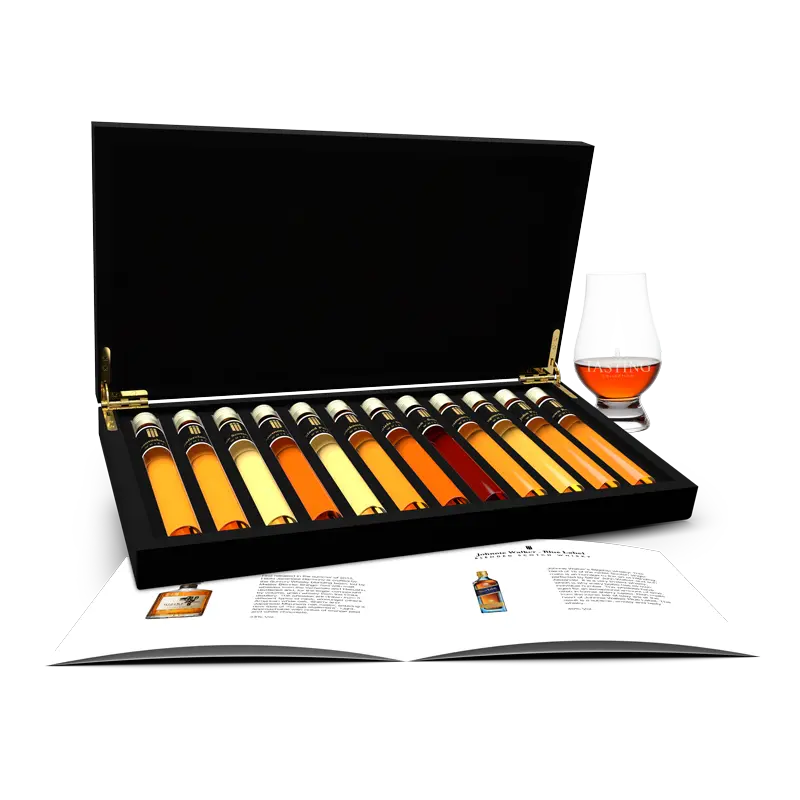Tasting Whisky
Learn how to taste whiskey
The art of tasting is one you can master. And that’s just a matter of getting started. We realize that the terms used to describe the whisky can sometimes be somewhat intimidating. Therefore, we are happy to take you through this activity that, the more you taste, the more interesting it will become.
The more whisky you taste, the easier it will become for you. Especially if, while tasting, you have information about the whisky in question at your disposal. If you read the background and make your own notes, you will immediately find that you easily become part of the world behind this wonderful drink. Nothing is more fun than tasting, discovering and learning.
We give you some beginner’s tips and all the common terms used in the world of whiskey. You do not have to learn them by heart, but you will see that, to describe a whisky for yourself, these terms can be quite handy.
The golden rule when tasting whisky is that taste is above all very personal. What you taste and how you judge it matters. If you taste together with another enthusiast, it is fun and educational to exchange your tasting experiences.
Hoe meer whisky u proeft, hoe gemakkelijker het u zal afgaan. Zeker als u, terwijl u proeft, informatie over de betreffende whisky tot uw beschikking heeft. Leest u de achtergrond en maakt u uw eigen notities, dan zult u direct merken dat u gemakkelijk onderdeel wordt van de wereld achter deze prachtige drank. Niets is leuker dan proeven, ontdekken en leren.
Wij geven u een aantal beginnerstips en alle veel gebruikte termen in de wereld van whisky. U hoeft ze niet uit uw hoofd te leren, maar u zult zien dat, om een whisky voor uzelf te omschrijven, kunnen deze termen best handig zijn.
De gouden regel bij het proeven van whisky is dat smaak bovenal zéér persoonlijk is. Wat ú proeft en hoe u dit beoordeelt, is van belang. Proeft u samen met een andere liefhebber, dan is het leuk en leerzaam om uw proefervaringen uit te wisselen.
Tasting slowly
Whisky is a special drink that should be tasted slowly. Allow yourself time to slowly release the character traits of the whisky. You will find that with most whiskies, your first sip will be very different from the second, and the third will be different from the second after a while….Whisky is a special drink that should be tasted slowly. Allow yourself time to slowly release the character traits of the whisky. You will find that with most whiskies, your first sip will be very different from the second, and the third will be different from the second after a while….
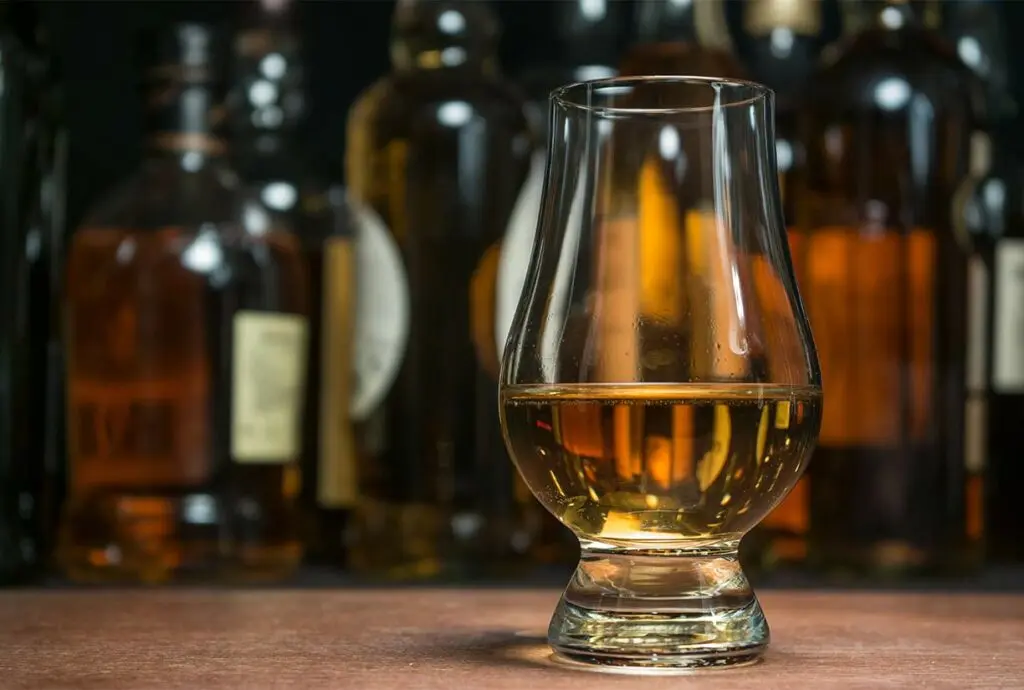
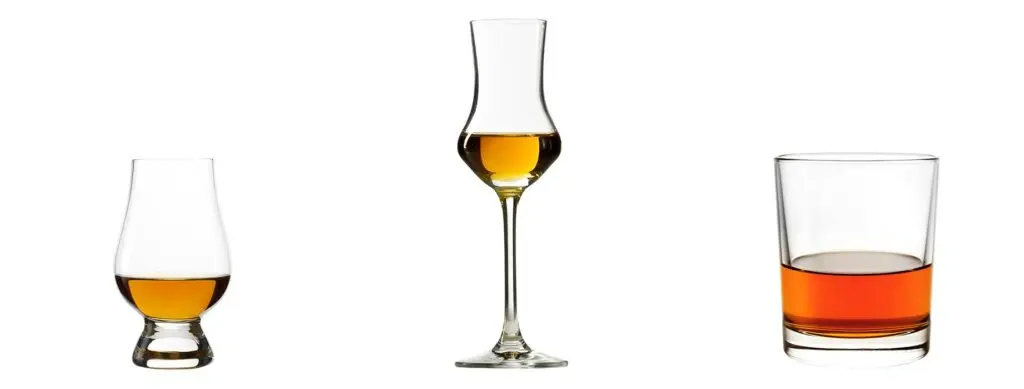
Whisky Glasses
Snifter
There is one type of glass suitable for proper whiskey tasting; the Snifter. This type of glass is designed to better conduct the aromas to the nose; after all, the nose is a very important factor in tasting. This glass has a tulip shape with a wide base and a narrowing toward the rim.
Tumbler
A tumbler; a wide glass with a thick bottom and no choke is less suitable for tasting, as the aromas can spread quickly. Therefore, preferably use a Tumbler only when you just want to enjoy a glass of whiskey.

The Nose
De Neus (Nose) van een whisky is het aroma dat u ruikt. De aroma’s geven een indicatie van hoe de whisky zal smaken. Giet het buisje Whisky in uw glas en laat het even rondgaan door een kleine zwierende polsbeweging te maken, waardoor de zuurstof wordt toegevoegd en verdamping kan beginnen. Dit is van belang omdat de whisky tot dan in het vat of de fles ‘gevangen’ heeft gezeten. Geef de whisky een beetje tijd om zijn karakteristieken te presenteren. Laat de whisky dan enkele tellen tot rust komen in het glas alvorens er aan te ruiken. Verwarm het glas iets door het in uw handpalm te houden. Ruikt u direct, dan zult u in veel gevallen een niet aangename alcohol of Aceton lucht ruiken. Let ondertussen op de kleur van de whisky.
Stop uw neus in het glas – letterlijk – en snuif de aroma’s op. Doe dit 3 keer en probeer de aroma’s te identificeren. Enkele veelgebruikte termen om het aroma aan te duiden zijn: licht, fris, zwaar, vol, fruitig, bloemachtig, kruidig, rokerig, turfachtig, etc. U zult merken dat uw eerste snuif vol alcohol zit, de tweede zoeter en fruitiger zal zijn en de derde een rokerige warmte uitstraalt. Probeer op basis hiervan gerust de smaak van de whisky te voorspellen.
The Taste
The Taste (Palate) is registered by the taste buds on your tongue. Of great importance is not to drink the whiskey too quickly. Hold it in your mouth for a while to allow the taste to circulate properly. Different parts of the tongue and mouth respond to different flavors and characteristics of the whisky. Now try to taste the characteristics and describe them for yourself in your own tasting notes. A little later, take another sip and try to discover new things in the process. Don’t worry if you taste something someone else doesn’t or vice versa. After all, our taste buds are all different.
The Aftertaste
The Aftertaste (Finish) is the taste that remains in the mouth after you swallow the whiskey. You will discover that the complexity of the finish sets whiskey apart from other spirits. Try to discover and describe as many flavors as you can. And make a comparison with flavors you know. With the aftertaste, also ask yourself whether it is short, medium or long.
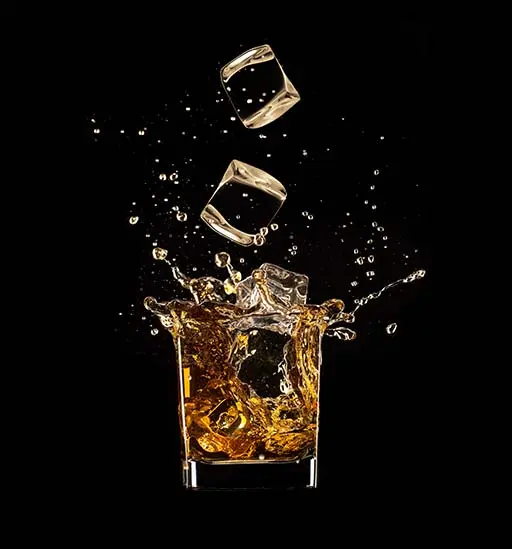
Add water or ice?
Adding water or ice can affect the whisky both positively and negatively. Most whiskies with an alcohol content between 40% and 45% have usually already had some water added through a process called cutting. This is done before bottling to tailor the taste to a wider range of consumers. Usually this cutting is done with natural water that can be found near the distillery.
IJs in Whisky
Adding ice is highly controversial. Some connoisseurs believe it is simply not done, but in the United States it is the custom to drink whiskey on the rocks. The difference with water is that ice immediately lowers the temperature in your glass and keeps the whiskey from showing its special characteristics. Moreover, it dilutes your whisky. Instead of bringing out the flavors better, ice will rather mask the flavors or prevent them from bursting forth, much like a good white wine served too cool. It will be more refreshing, of course, but the flavor is more likely to become dull. The flavor will only pick up slightly after the ice has melted and the whiskey can reheat, but by then the dram is too diluted to do justice. So for tasting purposes, we recommend not using ice.
Water in Whisky
Adding (a very small amount! ) of water can suddenly unleash a whole new set of characteristics in a whisky that you would not have tasted with a purewhisky. This is certainly the case with Cask Strength whiskies or whiskies with an alcohol content above 60%. The high alcohol content keeps the more subtle flavors from coming to the fore. A small amount of water quenches the alcohol a bit, allowing the flavors to emerge more fully. Exactly how much water to add depends, of course, on your personal taste. Feel free to experiment with this as well.
Conclusion
Our advice is always to first taste a whisky in its natural form, without additives (straight or neat). Some whisky connoisseurs believe that you should not add water to a whisky either, because you should taste it as it was originally made by the distillery, in all its natural beauty and complexity. However, adding a little water can help bring out even more flavors and complexity. Especially when it is a whisky with a high alcohol content, such as a Cask Strength.
Whisky stones
There is an alternative to adding ice cubes , when you want to avoid diluting the whiskey too much; Whisky Stones. These are stones shaped like ice cubes. Thus, they can be rinsed off and reused.
Even though these stones do not dilute your dram, they cool the whisky to the point that a lot of flavor is lost. The whiskey will only really come into its own when it slowly begins to warm back up. We therefore also advise against these Whisky Stones for tasting purposes.
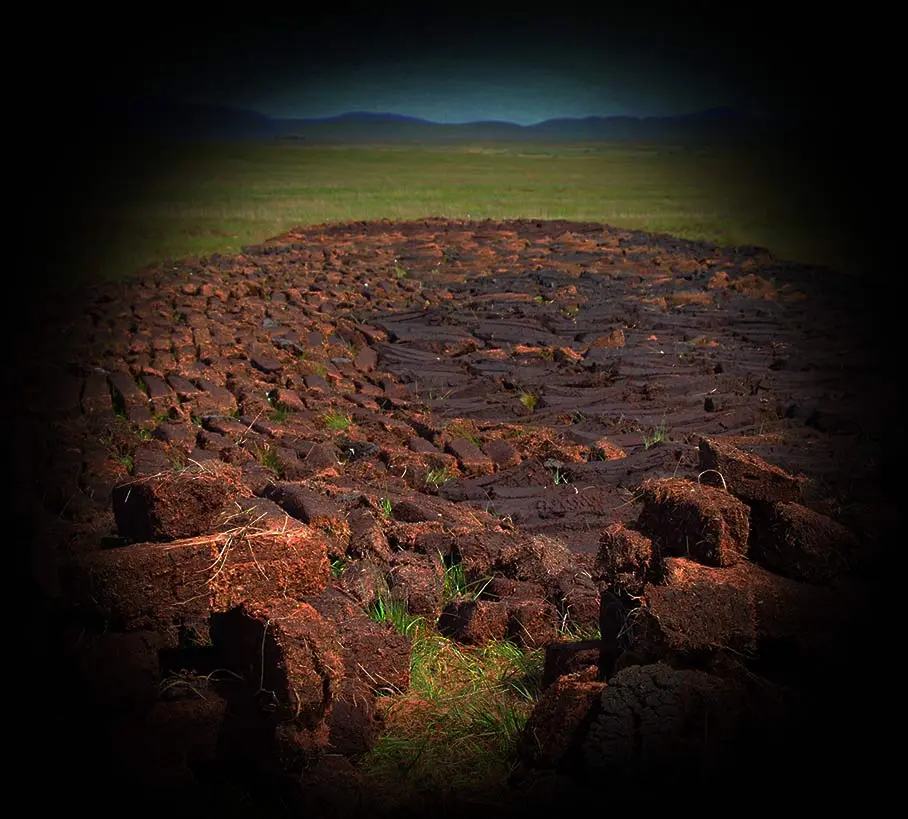
Peat
Peat is found almost everywhere in the British Isles and its use in the production of most Scotch whiskies creates that unique, smoky, flavor. Peat is earth composed of grasses, mosses, branches and roots that have been compressed into the soil over centuries.
The use
The mined peat is cut (usually by hand) and left to dry for about two weeks. Then it is taken to the distillery nearby. Usually the peat comes from land owned by the distillery itself. The peat is burned under the barley to obtain malt. Because the peat is so compact it burns for a very long time with a constant temperature and smoke.
Phenols
The use of peat is one of the reasons whiskies taste so different. The smoke from peat contains chemicals (phenols), which are absorbed by the barley during malting. The amount of phenols is determined by the length of time the barley was exposed to the smoke, the amount of smoke released when the peat was burned and, of course, the type of peat used.
When the malt is drained, the amount of phenols is measured. This is expressed in PPM – Parts Per Million. A distillery will always aim for the same PPM in its malt. The PPM is also measured in the finished product. The higher the PPM in the whiskey, the smokier it tastes.
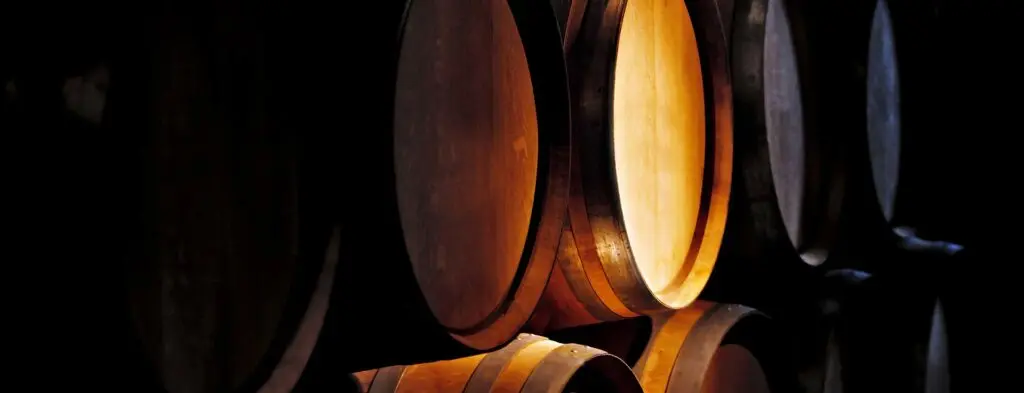
Influence of Wood on Whisky
The oak barrel or cask (cask) in which the whiskey was aged also affects its taste. That these barrels must be oak was established by law. The choice of this type of wood lies in the fact that it is strong, yet has a structure, which prevents leaks. It is porous, allowing oxygen to enter and exit the vessel. And the wood can be bent by heating without breaking; of importance in barrel production.
Hout zit vol natuurlijke oliën, die vanillins worden genoemd. De spirit trekt als het ware deze vanillins uit het vat tijdens het rijpingsproces en vormen dus mede de complexe smaak van de whisky. Er worden momenteel drie houttypes gebruikt in de productie van whisky. Deze hebben allemaal hun eigen specifieke kenmerken.
European oak
Dit type eik (Quercus Robur) wordt al meer dan tweehonderd jaar gebruikt in het rijpingsproces van Schotse whisky en Ierse whiskey. De eerste fusten werden gemaakt van Engelse en Schotse eiken, maar gezien de trage groei van deze lokale boom werd al snel uitgeweken naar Russische eik.
Vanaf 1860 begonnen de Britten sherry te importeren uit Spanje. De eiken vaten waarin de sherry gerijpt had waren gelijkaardig – van Spaanse eik – maar een stuk goedkoper.
Tegenwoordig wordt steeds meer gebruik gemaakt van Franse eik. Deze worden traditioneel gebruikt voor het rijpen van wijn en worden door de distilleerderijen voornamelijk gebruikt om een speciale afdronk aan hun whisky te bezorgen.
Enkele typische ‘smaak’-termen in combinatie met rijping op dit soort hout:
sherry, gedroogd fruit (rozijnen), kruiden (kaneel, nootmuskaat), karamel, sinas.
This type of oak (Quercus Robur) has been used in the aging process of Scotch whisky and Irish whiskey for over two hundred years. The first casks were made from English and Scotch oaks, but given the slow growth of this local tree, Russian oak was soon substituted.
Starting in 1860, the British began importing sherry from Spain. The oak barrels in which the sherry was aged were similar – of Spanish oak – but a lot cheaper.
Today, French oak is increasingly used. Traditionally used for aging wine, these are used by distilleries primarily to provide a special finish to their whiskey.
Some typical “flavor” terms associated with aging in this type of wood:
sherry, dried fruits (raisins), spices (cinnamon, nutmeg), caramel, orange.
Enkele typische ‘smaak’-termen in combinatie met rijping op dit soort hout:
sherry, gedroogd fruit (rozijnen), kruiden (kaneel, nootmuskaat), karamel, sinas.
American oak
This type of oak (Quercus Rubra) has only been used since the end of World War II, after a law was introduced to revitalize the barrel industry following the Prohibition of the 1920s and 1930s. The Irish and Scots also began using American bourbon casks to age their whiskies.
American oak is considered the perfect type of wood for whiskey casks because it grows quickly with a dead straight stump and a high content of vanillins. A typical American barrel, called the ASB (American Standard Barrel), is considered ideal because of the good ratio of the amount of spirit to the surface area of the inside of the barrel. Result: almost 90% of all whiskies worldwide are now aged in American oak bourbon casks.
Some typical “flavor” terms associated with aging in this type of wood:
vanilla, honey, nuts (coconut, almond, hazelnut), caramel and spice.
Japanese oak
This type of oak (Quercus Mongolica), better known as the Mizunara oak, has been used in the Japanese whiskey industry since 1930. The Mizunara has a particularly high vanillin content, but is soft and very porous. The wood can leak and is easily damaged. Therefore, even in Japan, bourbon or sherry barrels are mainly used to age the whiskey and only at the end of this aging process are transferred to Mizunara barrels to get the specific taste.
Some typical “flavor” terms associated with aging in this type of wood:
vanilla, honey, flowers, blossom, fresh fruits (pears, apples), spices (nutmeg, peppers), wood.
Types of whiskey barrels or casks
On a bottle of whiskey may be listed the type of cask on which it was aged. Here, the smaller the cask, the more the aging spirit came into contact with the wood of the cask around it and thus the greater the influence of the natural oils, the vanillins.
An overview of the different types of whiskey barrels:
Blood Tub
40 liter
The Blood Tub is mainly used for brewing beer, but very occasionally for aging whiskey, such as for special editions.
Quarter Cask
50 liter
The Quarter Cask is a barrel the size of one-fourth of an ASB (American Standard Barrel). Used because of the large contact between spirit and wood, giving the whiskey its flavor quickly. Sometimes also called firkin.
ASB (American Standard Barrel)
200 liter
The ASB is the “modern” whiskey barrel, easy to use given its capacity. Made from American oak. Used primarily in the bourbon industry, but also frequent for aging Scotch and Irish spirit.
Hogshead
225 liter
The Term Hogshead is derived from the 15th century English “Hogges Hede,” which corresponded to 63 gallons. The forerunners of the ASB and perhaps still the most widely used barrels in the world for aging whiskey.
Barrique
300 liter
Barrique is mainly used in the wine industry. The major difference with whiskey barrels is that they are bound with strips of wood rather than metal rings. They give a wine cask finish to the whiskey.
Puncheon
500 liter
Puncheon barrels are made from American oak or Spanish oak and used in the rum and sherry industries. They are used to give whiskey its finish.
Butt
500 liter
The Butt is a tall narrow barrel made from solid European oak. Are mainly used in the Spanish sherry industry. They are the most common sherry barrels used for aging whiskey.
Port Pipe
650 liter
The Port Pipe is also a tall narrow barrel made from solid European oak. Looks a bit like a pulled out barrel. These are mainly used for maturing Port to give whisky its finish afterward.
Madeira Drum
650 liter
The Madeira Drum is a short and round barrel of wide diameter made of French oak. As the name suggests, these barrels are mainly used in the Madeira wine industry. Sometimes used to give whiskey its finish.
Gorda
700 liter
The Gorda is a huge barrel that has its origins in the American whiskey industry. They are sometimes used to age whiskey, but mainly for blending (marrying) different whiskies together to obtain a blended or vatted whiskey.
The most commonly used barrels are the American Standard Barrel and the Butt.









 Nederland (en)
Nederland (en)


